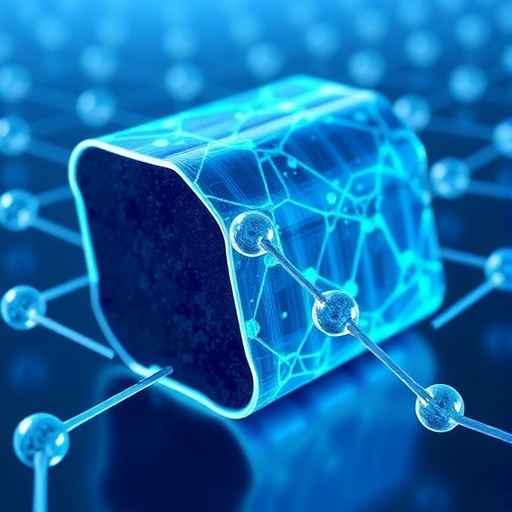In an era where sustainable energy solutions are imperative, advancements in lithium-ion battery technology remain pivotal to the future of energy storage and electric mobility. Researchers from a team comprising Rao, Zhou, and Wang have paved the way for enhanced battery efficiency through innovative materials. Their latest study details the synthesis of lithium nickel oxide (LiNiO₂) nanosheets derived from nickel carbonate (NiCO₃), a novel approach that has the potential to revolutionize the cathode materials used in lithium-ion batteries. This article delves into the implications and intricacies of their findings, underscoring the significance of their research in the broader context of energy storage technologies.
The synthesis of LiNiO₂ nanosheets is an important scientific achievement that could lead to more efficient energy storage solutions. Traditional cathode materials often suffer from issues such as poor structural stability and suboptimal electrochemical performance. However, the development of LiNiO₂ nanosheets demonstrates a marked improvement in these areas, offering a promising alternative to conventional materials. The research highlights the importance of nanosheet structures, which provide a higher surface area for lithium-ion intercalation, thereby enhancing the overall performance of the battery.
Furthermore, this method of using nickel carbonate as a precursor for the synthesis of LiNiO₂ showcases the potential for utilizing abundant and less toxic materials in battery production. Nickel carbonate is readily available and offers a sustainable path towards the production of high-performance battery components. By reducing dependence on scarce and environmentally harmful materials, this research aligns with global initiatives to transition towards more sustainable technologies, positioning the lithium-ion battery industry for a greener future.
.adsslot_Y2DKd09uW8{width:728px !important;height:90px !important;}
@media(max-width:1199px){ .adsslot_Y2DKd09uW8{width:468px !important;height:60px !important;}
}
@media(max-width:767px){ .adsslot_Y2DKd09uW8{width:320px !important;height:50px !important;}
}
ADVERTISEMENT
The researchers utilized a particular synthetic route that involves the thermal decomposition of the nickel carbonate precursor. This method not only ensures the formation of highly crystalline LiNiO₂ nanosheets but also allows for precise control over their morphology. Achieving a controlled nanosheet structure is crucial as it directly impacts the electrochemical properties of the material, leading to enhanced ionic and electronic conductivity. This aspect of the research is particularly noteworthy; strong conductivity is essential for achieving high power and energy densities in lithium-ion batteries.
To characterize the synthesized nanosheets, the team employed a range of techniques including X-ray diffraction (XRD), scanning electron microscopy (SEM), and transmission electron microscopy (TEM). The XRD results confirmed the successful crystallization of LiNiO₂ with a layered structure, while the electron microscopy techniques provided detailed insights into the morphology and thickness of the nanosheets. These investigations revealed that the nanosheets possess a uniform thickness, which is vital for maximizing their electrochemical performance in battery applications.
Further electrochemical testing was conducted to evaluate the performance of the synthesized LiNiO₂ nanosheets as cathode materials in lithium-ion batteries. The tests demonstrated a high specific capacity and exceptional cycling stability, indicating that these nanosheets could effectively serve in high-performance battery applications. Such characteristics are critical for the development of next-generation lithium-ion batteries that require higher energy densities and longer lifespans.
The research findings have implications that extend far beyond the confines of laboratory experiments. The global shift towards electric vehicles (EVs) and renewable energy solutions necessitates the development of battery technologies that are not only efficient but also sustainable. As the demand for high-energy and long-lasting batteries continues to grow, innovations like those presented by Rao and colleagues are vital to meet these challenges head-on.
Additionally, there is a growing awareness about the environmental impact of battery production and disposal. Finding sustainable sources for battery materials is crucial, as conventional methods often rely on materials that have detrimental effects on the environment. The use of less toxic materials, such as nickel carbonate, is a step towards addressing these concerns while ensuring that battery performance is not compromised.
The transition to more sustainable battery materials also enhances the recycling potential of lithium-ion batteries. By focusing on materials that are more environmentally friendly, this research could facilitate the development of recycling processes that are less labor-intensive and more efficient. The implications of such advancements are profound, as they could significantly reduce the environmental footprint associated with battery lifecycle management.
As the team continues to refine their synthesis methods and explore the electrochemical properties of LiNiO₂, the prospects for commercialization appear promising. Collaboration with industrial partners will be essential to accelerate the transition from research to market-ready solutions. This partnership could help to scale up the production of these advanced materials, bringing them into mainstream applications more swiftly.
In conclusion, the pioneering work of Rao, Zhou, and Wang on the synthesis of LiNiO₂ nanosheets heralds a new era in battery technology. Their findings not only demonstrate a significant advancement in cathode material design but also contribute to the urgent need for sustainable energy solutions. As the world grapples with energy shortages and the impacts of climate change, innovations in lithium-ion batteries will play a crucial role in shaping the future of energy storage and electric mobility.
This research not only pushes the boundaries of material science but also reflects the growing intersection of technology and sustainability. As the demand for efficient battery systems escalates, studies like this one provide a roadmap for developing next-generation energy storage solutions that are both high-performing and environmentally responsible. Ultimately, the future of energy storage may very well depend on the success of such innovative approaches, transforming the landscape and accelerating the transition towards a sustainable energy paradigm.
Subject of Research: Synthesis of LiNiO₂ nanosheets from NiCO₃ for lithium-ion batteries
Article Title: Synthesis of LiNiO₂ nanosheets from NiCO₃ as cathode material for high-performance lithium-ion batteries
Article References: Rao, Y., Zhou, Q., Wang, X. et al. Synthesis of LiNiO₂ nanosheets from NiCO₃ as cathode material for high-performance lithium-ion batteries. Ionics (2025). https://doi.org/10.1007/s11581-025-06545-1
Image Credits: AI Generated
DOI: https://doi.org/10.1007/s11581-025-06545-1
Keywords: lithium-ion batteries, LiNiO₂, nickel carbonate, nanosheets, energy storage, sustainability, electrochemical performance, cathode materials, renewable energy, electric vehicles.
Tags: advanced cathode materialselectric mobility advancementselectrochemical performance improvementenergy storage innovationsenergy storage technologiesLiNiO2 nanosheetslithium-ion battery technologylithium-ion intercalation enhancementnickel carbonate precursorresearch in battery materialsstructural stability in batteriessustainable energy solutions





